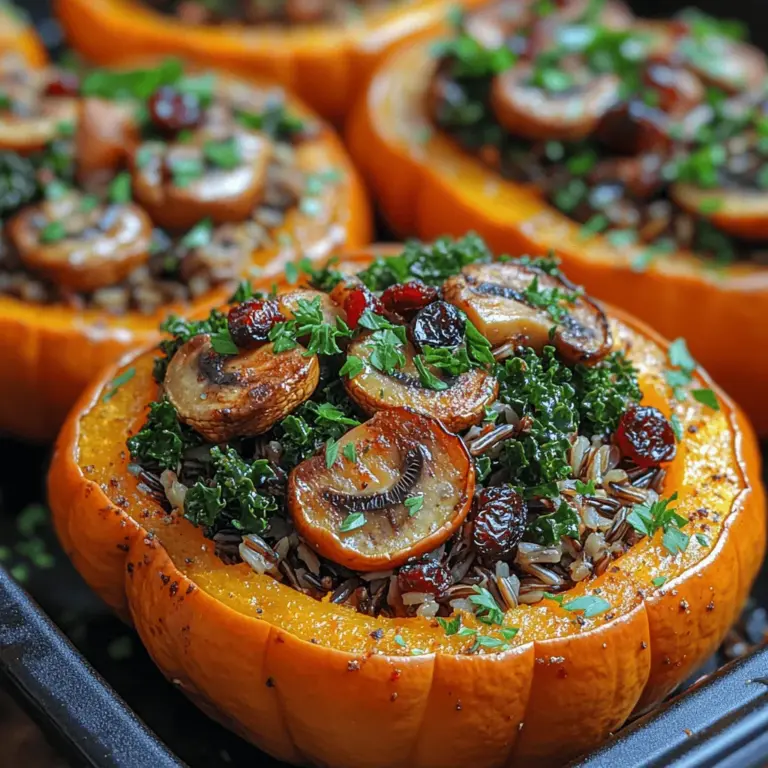Introduction
As the leaves begin to turn and the air becomes crisp, the allure of seasonal dishes grows stronger. Autumn brings a bounty of ingredients that not only mark the changing season but also offer a comforting, nourishing experience. One such ingredient that shines during this time is acorn squash, a beautiful, petite gourd that embodies the essence of fall. Its unique shape and rich, sweet flavor make it a versatile canvas for a variety of fillings, but none quite as delightful as a stuffing of wild rice, kale, and walnuts. This recipe for Stuffed Acorn Squash with Wild Rice is not only a feast for the eyes but also a celebration of health, flavor, and seasonal cooking.
Acorn squash is an excellent addition to any autumn menu, providing a hearty, satisfying base that pairs wonderfully with its stuffing. The combination of wild rice, with its nutty flavor and chewy texture, along with nutrient-rich kale and crunchy walnuts, creates a dish that is both hearty and wholesome. Perfect for gatherings or cozy family dinners, this recipe encapsulates the spirit of the harvest season, allowing you to enjoy the flavors that autumn has to offer.
Understanding Acorn Squash
Acorn squash is easily recognizable by its distinctive acorn shape and deep green or yellow skin, often adorned with ridges. Unlike other squash varieties that can be bland, acorn squash boasts a creamy, sweet flavor that intensifies when roasted. This versatility allows it to shine in both savory and sweet dishes, making it a staple in many kitchens as the weather cools.
Nutritionally, acorn squash is a powerhouse. It is low in calories, yet high in vitamins A and C, which are essential for maintaining a healthy immune system and promoting good vision. Additionally, it contains potassium, which plays a key role in heart health and muscle function. With only 56 calories per cup, acorn squash is an excellent option for those looking to enjoy a filling meal without compromising on their dietary goals.
When selecting acorn squash at the market, look for fruits that are heavy for their size, with a firm skin and no soft spots. They should be free of blemishes, and the color should be vibrant. Acorn squash can be stored in a cool, dry place for several weeks, making it a convenient option for meal planning throughout the autumn season.
The culinary uses of acorn squash are almost limitless. It can be roasted, pureed, or even used in soups and salads. For this recipe, however, we will focus on its ability to serve as a perfect vessel for a savory stuffing, allowing the flavors of wild rice, kale, walnuts, and spices to meld beautifully as they bake together.
The Health Benefits of the Ingredients
At the heart of this Stuffed Acorn Squash recipe is wild rice, a unique grain that is not only delicious but also incredibly nutritious. Unlike traditional white rice, wild rice is a whole grain, packed with fiber, protein, and essential minerals. One cup of cooked wild rice provides about 30% of the daily recommended intake of fiber, which aids in digestion and helps maintain a healthy weight. Additionally, wild rice contains antioxidants that may help to reduce inflammation and promote overall health.
Kale, a superfood in its own right, is another star ingredient in this dish. Rich in vitamins A, C, and K, kale provides a substantial boost to your nutrient intake. It is also a great source of calcium, iron, and potassium, making it an excellent addition to any meal. For those who may prefer a milder flavor, spinach can be used as a substitute, still providing a wealth of vitamins and minerals without overpowering the dish.
Walnuts add a delightful crunch to the stuffing, alongside their numerous health benefits. They are a fantastic source of omega-3 fatty acids, which are essential for heart health and brain function. Incorporating nuts into your diet can also help reduce inflammation and improve cholesterol levels. Furthermore, the addition of dried fruits, such as cranberries, introduces a touch of sweetness while providing antioxidants and vitamins.
To enhance the flavor profile of the stuffing, vegetable broth plays a crucial role. It not only adds depth to the dish but also caters to dietary considerations, making the recipe suitable for vegans and vegetarians alike. Using a high-quality vegetable broth can greatly enhance the overall flavor of the stuffed acorn squash, ensuring that every bite is both satisfying and delicious.
Preparing the Stuffed Acorn Squash
To start preparing your Stuffed Acorn Squash with Wild Rice, the first step is to properly prepare the acorn squash for roasting. Begin by preheating your oven to 400°F (200°C). While the oven is heating, carefully slice each acorn squash in half lengthwise. Use a spoon to scoop out the seeds and fibrous flesh from the center, making sure to create enough space for the delicious stuffing that will follow.
Next, place the squash halves cut-side up on a baking sheet lined with parchment paper. To enhance the natural sweetness of the squash during roasting, drizzle a bit of olive oil over the cut sides and sprinkle them with salt and pepper. This simple seasoning will elevate the flavors and create a beautifully caramelized exterior. Roast the acorn squash halves in the preheated oven for about 25-30 minutes, or until they are tender and easily pierced with a fork. This step is crucial as it allows the squash to soften and develop its sweet, nutty flavor, setting the stage for the stuffing to come.
While the squash is roasting, it’s time to cook the wild rice. Rinse the rice under cold water to remove any excess starch, which can cause it to become gummy during cooking. This simple step ensures that your wild rice will be fluffy and perfectly cooked. In a medium saucepan, combine one cup of wild rice with three cups of vegetable broth. Bring the mixture to a boil, then reduce the heat to low, cover, and let it simmer for about 45-50 minutes. Wild rice takes longer to cook than white or brown rice, but the resulting texture is well worth the wait. Check the rice periodically, adding additional broth or water as needed to prevent it from drying out. Once the rice is tender and the grains have split open, remove it from the heat and set it aside to cool slightly before incorporating it into the stuffing.
Now that your acorn squash is roasting and the wild rice is cooking, it’s time to sauté the vegetables. This step is essential for building flavor and ensuring that your stuffing is both aromatic and satisfying. In a large skillet, heat a tablespoon of olive oil over medium heat. Add finely chopped onions and garlic, sautéing them until they become translucent and fragrant, about 3-4 minutes. Next, add your kale (or spinach) to the skillet, cooking it down until it wilts and softens, which should take an additional 3-5 minutes. This process not only helps to break down the greens but also allows their flavors to meld together, creating a rich base for your stuffing.
Following the sautéing of the greens, incorporate the cooked wild rice into the skillet, stirring to combine all the ingredients. At this point, you can also add the chopped walnuts and dried cranberries, mixing them in to create a filling that is flavorful and nutritious. Season the mixture with salt, pepper, and any additional spices you prefer, such as thyme or sage, to enhance the autumnal flavors of the dish.
As you prepare to assemble your Stuffed Acorn Squash, take a moment to taste the filling. Adjust the seasoning as necessary, ensuring that each bite will be bursting with flavor. Once satisfied with the stuffing, it’s time to fill each roasted acorn squash half with the wild rice mixture, pressing it down gently to pack it in.
Now, the squash is ready to return to the oven for a final round of roasting. This allows the flavors to meld together and the stuffing to heat through. Bake the stuffed acorn squash for an additional 15-20 minutes, or until the tops are golden and slightly crispy. The result is a beautiful, vibrant dish that not only looks impressive but also encapsulates the warmth and comfort of autumn dining.
By following these steps, you’ll create a stunning and delicious meal that showcases the best of seasonal ingredients. Stay tuned for the next section, where we’ll explore tips for achieving the best results and answer common questions about this delightful recipe.

Step-by-Step Guide on Sautéing Onions, Garlic, and Mushrooms
To create a delicious stuffing for our Harvest Harmony: Stuffed Acorn Squash with Wild Rice, it is essential to start with a solid flavor foundation. Sautéing onions, garlic, and mushrooms properly will elevate the dish and bring out the natural sweetness and umami of these ingredients.
Sautéing Techniques:
1. Heat the Pan: Begin by heating a large skillet over medium heat. Add a drizzle of olive oil or a tablespoon of butter. Allow it to warm until it shimmers, indicating that it’s ready for the vegetables.
2. Onion First: Add diced onions to the pan first. Onions take longer to soften than garlic and mushrooms, so they should be sautéed for about 5-7 minutes until they become translucent and fragrant. Stir occasionally to prevent them from browning too quickly.
3. Adding Garlic: Once the onions are softened, add minced garlic. Garlic cooks quickly, so sauté it for only 1-2 minutes. Stir continuously to prevent it from burning, which can lead to a bitter flavor.
4. Mushrooms Last: Add sliced mushrooms to the pan after the garlic has cooked. Mushrooms release moisture as they cook, which helps deglaze the pan and pick up any caramelized bits left by the onions and garlic. Sauté them for 5-7 minutes until they are golden brown and have released their liquid.
5. Seasoning: Towards the end of the sautéing process, season the mixture with salt and pepper. This ensures that the flavors are balanced throughout the stuffing. You can also add herbs like thyme or sage at this stage to deepen the flavor profile.
Insights into the Flavor-Building Process
The sequence of adding ingredients while sautéing is crucial for developing robust flavors in your stuffing. Each ingredient contributes to the overall taste profile of the dish.
– Onions provide sweetness and depth, which forms the base of your stuffing.
– Garlic adds a pungent, aromatic quality that enhances the overall flavor.
– Mushrooms introduce earthiness and moisture, creating a rich, umami component.
By sautéing these ingredients in the correct order, you allow each one to reach its full flavor potential, ensuring a balanced and satisfying stuffing mixture.
The Importance of Proper Cooking Techniques for Kale/Spinach
When it comes to adding greens like kale or spinach to your stuffing, the cooking technique matters significantly.
– Wilting Greens: If using spinach, simply add it to the pan after the mushrooms have cooked and stir until just wilted. This will take about 2-3 minutes. Spinach cooks down quickly and retains much of its nutrients when lightly sautéed.
– Cooking Kale: Kale is more fibrous and requires a bit more time. Chop the kale finely and add it to the pan with a splash of vegetable broth or water. Cover and let it steam for about 5 minutes until it softens. Cooking kale this way ensures that it maintains its vibrant color and nutrient content while integrating well into the stuffing.
Creating the Stuffing Mixture
Now that you’ve prepared your base of sautéed vegetables, it’s time to create the stuffing mixture.
1. Combine Ingredients: In a large bowl, combine the sautéed onions, garlic, mushrooms, and greens with the cooked wild rice. This should be about 2-3 cups of wild rice, depending on how much you want to fill the squash.
2. Add Flavor Enhancers: For a balanced filling, consider adding ingredients like chopped walnuts for crunch, dried cranberries for sweetness, and a sprinkle of cheese (like feta or parmesan) for creaminess. Each of these components not only adds texture and flavor but also enhances the nutritional profile of the dish.
3. Mix Thoroughly: It’s essential to mix all ingredients thoroughly to ensure that flavors are evenly distributed. This helps prevent any one flavor from overpowering the others and ensures a delightful bite every time.
Tips for Customizing the Filling
One of the joys of cooking is adapting recipes to suit your taste or dietary preferences. Here are some customization options for your stuffing:
– Protein Options: For a heartier filling, consider adding cooked ground turkey, sausage, or plant-based meat alternatives. This addition will make the dish more filling and increase its protein content.
– Nut-Free Alternatives: If you have nut allergies, feel free to omit walnuts or replace them with sunflower seeds or pumpkin seeds for a similar crunch without the allergens.
– Herb Variations: Fresh herbs like parsley, basil, or rosemary can be added to enhance freshness. Adjust the herbs according to your seasonal preferences or what you have on hand.
Stuffing and Baking the Acorn Squash
Once your stuffing mixture is ready, it’s time to fill the acorn squash.
Stuffing Techniques:
1. Fill with Care: Spoon the stuffing mixture into each half of the roasted acorn squash. Press down gently to pack the filling without overstuffing, as this can cause spillage during baking.
2. Placement in Baking Dish: Arrange the stuffed squash halves in a baking dish. If you have any leftover stuffing, you can place it around the squash in the dish for additional flavor.
Baking Process:
1. Cover for Moisture: Cover the dish with aluminum foil for the first half of the baking time. This helps retain moisture and ensures even cooking of the squash and stuffing.
2. Baking Time: Bake in a preheated oven at 375°F (190°C) for about 30-40 minutes. After the first 20 minutes, remove the foil to allow the tops of the stuffing to crisp up slightly.
3. Checking Doneness: The acorn squash is done when it is tender and can be pierced easily with a fork. The stuffing should also be heated through and slightly golden on top.
4. Resting Time: Once out of the oven, let the stuffed squash rest for about 10 minutes before serving. This resting period allows the flavors to meld beautifully, enhancing the overall taste of the dish.
Serving Suggestions and Pairings
Harvest Harmony: Stuffed Acorn Squash with Wild Rice is not only beautiful but also versatile when it comes to serving options. Here are some ideas for complementing this dish:
1. Side Dishes: Pair the stuffed squash with a simple green salad or steamed vegetables. A light vinaigrette can brighten the meal and enhance the flavors.
2. Presentation Ideas: For gatherings, serve the stuffed squash on a large platter garnished with fresh herbs. This presentation can be enhanced with a drizzle of balsamic reduction or a sprinkle of pomegranate seeds for a festive touch.
3. Beverage Pairings: Consider serving this dish with a crisp white wine like Sauvignon Blanc or a light-bodied red like Pinot Noir. For non-alcoholic options, a sparkling apple cider or herbal iced tea can complement the flavors beautifully.
Conclusion
The Harvest Harmony: Stuffed Acorn Squash with Wild Rice is an inviting dish that exemplifies the beauty of seasonal cooking. Its combination of sweet roasted squash and savory stuffing makes it an ideal centerpiece for fall gatherings or a healthy weeknight meal.
As you experiment with this recipe, take the time to appreciate the joy of cooking with seasonal ingredients and sharing these nourishing meals with loved ones. Whether you’re hosting a festive dinner or simply enjoying a night in, this stuffed acorn squash will surely be a delightful addition to your culinary repertoire. Embrace the flavors of the season, and happy cooking!


